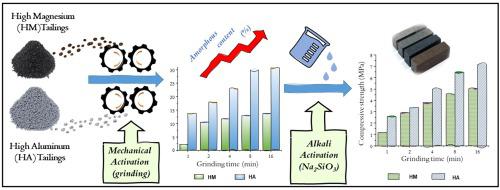当前位置:
X-MOL 学术
›
Miner. Eng.
›
论文详情
Our official English website, www.x-mol.net, welcomes your
feedback! (Note: you will need to create a separate account there.)
Upcycling of mechanically treated silicate mine tailings as alkali activated binders
Minerals Engineering ( IF 4.9 ) Pub Date : 2020-11-01 , DOI: 10.1016/j.mineng.2020.106587 Priyadharshini Perumal , He Niu , Jenni Kiventerä , Paivo Kinnunen , Mirja Illikainen
Minerals Engineering ( IF 4.9 ) Pub Date : 2020-11-01 , DOI: 10.1016/j.mineng.2020.106587 Priyadharshini Perumal , He Niu , Jenni Kiventerä , Paivo Kinnunen , Mirja Illikainen

|
Abstract Mining activity is inevitable in human societies, and thus, disposal of mining waste in a proper and effective way is crucial to preserving our environment. In this context, studies on the reuse potential for mine tailings in the construction sector are booming. However, utilizing tailings as binder material is complicated due to the high variation in mineralogical composition and the low reactivity of these materials. In this study, an attempt was made to understand the effect of mechanical treatment on silicate mine tailings in order to improve their properties for use as a sole precursor in alkali-activated binders. Two different silicate tailings from Finland were studied: one rich in tremolite, which is high in magnesium (HM tailings) and one rich in anorthite and epidote, which is high in aluminum (HA tailings). Interestingly, grinding activity performed at different durations affected the properties of the tailings with various intensities, including their mineralogical and physical properties and characteristics and, thus the reactivity of tailings. Tremolite does not respond to milling for longer durations, and layered anorthite was easily distorted by the mechanical disturbance. Irrespective of the type of tailings, the compressive strength of alkali-activated milled tailings increased with an increase in grinding time from 1 to 16 min. However, the percentage of compressive strength increase varied with the type of tailings and their mineralogy.
中文翻译:

机械处理的硅酸盐尾矿作为碱活化粘合剂的升级改造
摘要 采矿活动在人类社会中是不可避免的,因此,以适当有效的方式处理采矿废物对于保护我们的环境至关重要。在此背景下,对建筑行业尾矿再利用潜力的研究正在蓬勃发展。然而,由于矿物组成的高度变化和这些材料的低反应性,将尾矿用作粘合剂材料是复杂的。在这项研究中,试图了解机械处理对硅酸盐尾矿的影响,以改善其用作碱活化粘合剂的唯一前体的性能。研究了来自芬兰的两种不同的硅酸盐尾矿:一种富含透闪石,镁含量高(HM 尾矿),另一种富含钙长石和绿帘石,铝含量高(HA 尾矿)。有趣的是,在不同持续时间进行的研磨活动以不同的强度影响尾矿的特性,包括其矿物和物理特性和特性,从而影响尾矿的反应性。透闪石在较长时间内对碾磨没有反应,层状钙长石很容易因机械干扰而变形。不考虑尾矿的类型,碱活化研磨尾矿的抗压强度随着研磨时间从 1 分钟增加到 16 分钟而增加。然而,抗压强度增加的百分比随尾矿的类型及其矿物学而变化。透闪石在较长时间内对碾磨没有反应,层状钙长石很容易因机械干扰而变形。不考虑尾矿的类型,碱活化研磨尾矿的抗压强度随着研磨时间从 1 分钟增加到 16 分钟而增加。然而,抗压强度增加的百分比随尾矿的类型及其矿物学而变化。透闪石在较长时间内对碾磨没有反应,层状钙长石很容易因机械干扰而变形。不考虑尾矿的类型,碱活化研磨尾矿的抗压强度随着研磨时间从 1 分钟增加到 16 分钟而增加。然而,抗压强度增加的百分比随尾矿的类型及其矿物学而变化。
更新日期:2020-11-01
中文翻译:

机械处理的硅酸盐尾矿作为碱活化粘合剂的升级改造
摘要 采矿活动在人类社会中是不可避免的,因此,以适当有效的方式处理采矿废物对于保护我们的环境至关重要。在此背景下,对建筑行业尾矿再利用潜力的研究正在蓬勃发展。然而,由于矿物组成的高度变化和这些材料的低反应性,将尾矿用作粘合剂材料是复杂的。在这项研究中,试图了解机械处理对硅酸盐尾矿的影响,以改善其用作碱活化粘合剂的唯一前体的性能。研究了来自芬兰的两种不同的硅酸盐尾矿:一种富含透闪石,镁含量高(HM 尾矿),另一种富含钙长石和绿帘石,铝含量高(HA 尾矿)。有趣的是,在不同持续时间进行的研磨活动以不同的强度影响尾矿的特性,包括其矿物和物理特性和特性,从而影响尾矿的反应性。透闪石在较长时间内对碾磨没有反应,层状钙长石很容易因机械干扰而变形。不考虑尾矿的类型,碱活化研磨尾矿的抗压强度随着研磨时间从 1 分钟增加到 16 分钟而增加。然而,抗压强度增加的百分比随尾矿的类型及其矿物学而变化。透闪石在较长时间内对碾磨没有反应,层状钙长石很容易因机械干扰而变形。不考虑尾矿的类型,碱活化研磨尾矿的抗压强度随着研磨时间从 1 分钟增加到 16 分钟而增加。然而,抗压强度增加的百分比随尾矿的类型及其矿物学而变化。透闪石在较长时间内对碾磨没有反应,层状钙长石很容易因机械干扰而变形。不考虑尾矿的类型,碱活化研磨尾矿的抗压强度随着研磨时间从 1 分钟增加到 16 分钟而增加。然而,抗压强度增加的百分比随尾矿的类型及其矿物学而变化。











































 京公网安备 11010802027423号
京公网安备 11010802027423号